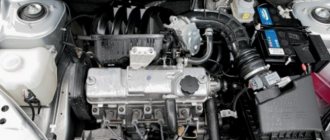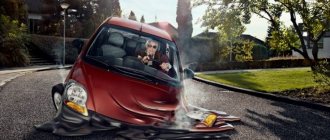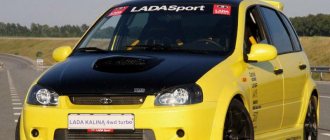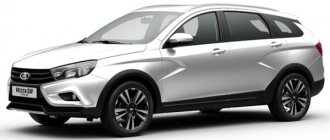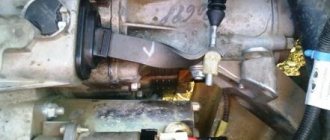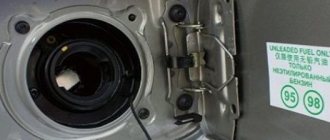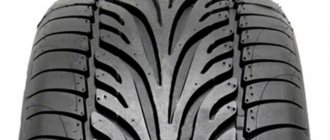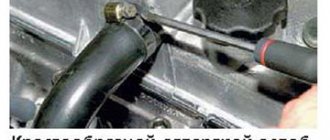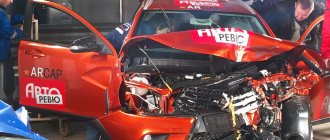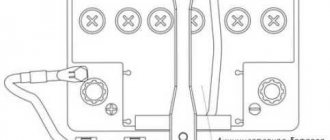When comparing the Datsun mi-DO and Lada Kalina, car enthusiasts are faced with a difficult question: “Which hatchback is better?” Indeed, in fact, one of the cars can easily surpass the other in some parameters, but be noticeably inferior in the rest. For example, the domestic Lada is superior to Datsun in practicality and more powerful power units, but inferior to it in equipment and style.
The choice between Mi-DO and Kalina is complicated by the fact that the cars have approximately the same price category.
Lada is inferior to Datsun in prestige
You shouldn’t think that the Japanese are superior in popularity to the domestic representative. Both cars are assembled at identical rates and roll off the assembly line of the same plant. But the psychology of the Russian consumer is built a little differently and when choosing a car, it leans towards foreign cars. Consequently, when choosing a more prestigious vehicle between the Datsun mi-DO and Lada Kalina, the consumer gives preference to Japanese roots.
Differences in Exterior
The aggressive look of Kalina's air intake takes up a large space in the front of the car. The hatchback looks confident from the front, having a narrow and long radiator grille, stylish head optics and modest fog lights. In profile the car is less swift and aggressive. The stern looks frankly modest: decorated with reflectors and oblong feet.
In comparison of the hatchback bodies of the Datsun mi-DO and Lada Kalina, the second representative looks more efficient.
Datsun has not stepped forward far, but in some nuances the differences are noticeable. The front of the car does not look as efficient as that of the Russian representative, but the combination of a hexagonal air intake near the radiator grille is well chosen. The chrome surround of the grille clearly completes the exterior composition. Looking at the Datsun mi-DO and Lada Kalina in profile, there are no significant differences, and relative to the stern, the difference is noticeable only in the configuration of the rear door.
Power comparison
Lada Kalina is the undisputed leader in this regard. The car has twice as many power units. Absolutely all engines have a volume of 1.6 liters. If there is an injector and an in-line arrangement, the power of the units may vary noticeably.
Datsun mi-DO has engines of 82 and 87 horses, while the first option is eight-valve. The power limit of the power units is reached at 5100 rpm, while the power thrust is 132 and 140 Nm (3800 rpm).
Lada Kalina does not have an 82-horsepower engine in its collection. But it has more powerful representatives - an engine of 98 horsepower has 5600 revolutions and a thrust of 145 Nm (4500 rpm) and an engine of 106 horsepower has 5800 revolutions and a thrust of 148 Nm (4000 rpm). There is also a sports version of the engine, which has an output of 118 horses (6750 rpm) and a torque of 154 Nm (4750 rpm).
Lada Kalina has more powerful engines, which outperforms its competitors in terms of power.
Datsun mi-DO and Lada Kalina: comparison of hatchbacks
When comparing the Datsun mi-DO and Lada Kalina, car enthusiasts are faced with a difficult question: “Which hatchback is better?” Indeed, in fact, one of the cars can easily surpass the other in some parameters, but be noticeably inferior in the rest. For example, the domestic Lada is superior to Datsun in practicality and more powerful power units, but inferior to it in equipment and style.
The choice between Mi-DO and Kalina is complicated by the fact that the cars have approximately the same price category.
Lada is inferior to Datsun in prestige
You shouldn’t think that the Japanese are superior in popularity to the domestic representative. Both cars are assembled at identical rates and roll off the assembly line of the same plant. But the psychology of the Russian consumer is built a little differently and when choosing a car, it leans towards foreign cars. Consequently, when choosing a more prestigious vehicle between the Datsun mi-DO and Lada Kalina, the consumer gives preference to Japanese roots.
Comparison by body type
Upon a superficial analysis of the choice of car body, the Lada looks more practical than the Datsun. It has sports and cross versions at its disposal, but this issue is controversial, because Datsun plans to acquire similar bodies, as the developers themselves and concept art on the Internet say. It turns out that the predominance of bodies in the assortment is only a matter of time.
Differences in Exterior
The aggressive look of Kalina's air intake takes up a large space in the front of the car.
The hatchback looks confident from the front, having a narrow and long radiator grille, stylish head optics and modest fog lights. In profile the car is less swift and aggressive. The stern looks frankly modest: decorated with reflectors and oblong feet. In comparison of the hatchback bodies of the Datsun mi-DO and Lada Kalina, the second representative looks more efficient.
Datsun has not stepped forward far, but in some nuances the differences are noticeable. The front of the car does not look as efficient as that of the Russian representative, but the combination of a hexagonal air intake near the radiator grille is well chosen. The chrome surround of the grille clearly completes the exterior composition. Looking at the Datsun mi-DO and Lada Kalina in profile, there are no significant differences, and relative to the stern, the difference is noticeable only in the configuration of the rear door.
Power comparison
Lada Kalina is the undisputed leader in this regard.
The car has twice as many power units. Absolutely all engines have a volume of 1.6 liters. If there is an injector and an in-line arrangement, the power of the units may vary noticeably. Datsun mi-DO has engines of 82 and 87 horses, while the first option is eight-valve. The power limit of the power units is reached at 5100 rpm, while the power thrust is 132 and 140 Nm (3800 rpm).
Lada Kalina does not have an 82-horsepower engine in its collection. But it has more powerful representatives - an engine of 98 horsepower has 5600 revolutions and a thrust of 145 Nm (4500 rpm) and an engine of 106 horsepower has 5800 revolutions and a thrust of 148 Nm (4000 rpm). There is also a sports version of the engine, which has an output of 118 horses (6750 rpm) and a torque of 154 Nm (4750 rpm).
Lada Kalina has more powerful engines, which outperforms its competitors in terms of power.
Transmission
There is not much difference in the choice of gearbox. Comparing both models, it should be noted that they have a five-speed manual transmission and a four-speed automatic transmission. For modern cars this is not much.
Suspension
Datsun mi-DO and Lada Kalina have identical chassis.
The front is the well-known McPherson strut, and the rear is a torsion beam. Both models have a typical B-Class design. Road stability and handling are at the proper level. The high ground clearance is felt during sharp turns, but these are not sports cars being compared. As with the gearbox, the cars have parity in the suspension.
Interior similarities
Both representatives have tangible similarities in the interior.
The developers didn’t try to be too clever and designed the Datsun mi-DO following the example of the Lada Kalina, as they say, “let’s go with the rules.” On the front panel, common lines are noticeable - three-spoke steering wheels, similarities in the configuration of the center console, the style of the instrument panel, cup holders, air deflectors, the glove box, and the location of the controls.
The compared Datsun mi-DO and Lada Kalina models have well-profiled seats, but lateral support is frankly lame in both versions. Both cars boast comfortable rear seats. There is also a high roof, which will allow passengers not to rest their heads on the ceiling.
Complete sets at one price
In approximately the same basic configurations, the Datsun mi-DO is superior to the Lada Kalina. In terms of safety, the Japanese hatchback is better equipped. In addition to the standard elements for most B-class models (ISOFIX mount, electric front windows, central locking, radio preparation), for the same money the Japanese is equipped with:
- anti-lock braking system ABS,
- EBD brake force distribution,
- EBA emergency braking assistance system.
In more advanced configurations, both Lada Kalina and Datsun Mi-DO cars boast:
- a pair of front airbags for safety (Datsun has additional side airbags),
- ESP stabilization system,
- fifteen-inch wheels,
- fog lights,
- electrical package,
- air conditioning (MI-DO has climate control),
- heated mirrors and seats,
- parking sensors,
- navigation,
- audio systems with displays and other options.
In price comparisons, the Datsun mi-DO slightly outperforms the Lada Kalina.
What's the result?
Comparing the Datsun Mi-DO and Lada Kalina hatchbacks, the result is cars with approximately the same cost and technical characteristics. This further complicates consumer choice.
Interior similarities
Both representatives have tangible similarities in the interior. The developers didn’t try to be too clever and designed the Datsun mi-DO following the example of the Lada Kalina, as they say, “let’s go with the rules.”
On the front panel, common lines are noticeable - three-spoke steering wheels, similarities in the configuration of the center console, the style of the instrument panel, cup holders, air deflectors, the glove box, and the location of the controls.
The compared Datsun mi-DO and Lada Kalina models have well-profiled seats, but lateral support is frankly lame in both versions. Both cars boast comfortable rear seats. There is also a high roof, which will allow passengers not to rest their heads on the ceiling.
DATSUN mi-DO
Specifications
| COMMON DATA | |
| Dimensions, mm: length / width / height / base | 3950 / 1700 / 1500 / 2476 |
| front/rear track | 1430 / 1410 |
| Trunk volume, l | 240 |
| Turning radius, m | 4,5 |
| Curb / gross weight, kg | 1160 / 1560 |
| Acceleration time 0 - 100 km/h, s | 14,3 |
| Maximum speed, km/h | 165 |
| Fuel / fuel reserve, l | A95/50 |
| Fuel consumption: urban/suburban/combined cycle, l/100 km | 10,4 / 6,1 / 7,7 |
| ENGINE | |
| Location | Front transverse |
| Configuration / number of valves | P4/8 |
| Working volume, cubic meters cm | 1596 |
| Compression ratio | 10,3 |
| Power, kW/hp | 64 / 87 at 5100 rpm. |
| Torque, Nm | 140 at 3800 rpm. |
| TRANSMISSION | |
| Type | front-wheel drive |
| Transmission | A4 |
| Gear ratios: I / II / III / IV / Z.H. | 2,86 / 1,56 / 1,00 / 0,70 / 2,31 |
| main gear | 4,1 |
| CHASSIS | |
| Suspension: front/rear | McPherson / elastic beam |
| Steering | rack and pinion with electric booster |
| Brakes: front / rear | ventilated disc / drum |
| Tire size | 185/60R14 |
Complete sets at one price
In approximately the same basic configurations, the Datsun mi-DO is superior to the Lada Kalina. In terms of safety, the Japanese hatchback is better equipped. In addition to the standard elements for most B-class models (ISOFIX mount, electric front windows, central locking, radio preparation), for the same money the Japanese is equipped with:
- anti-lock braking system ABS,
- EBD brake force distribution,
- EBA emergency braking assistance system.
In more advanced configurations, both Lada Kalina and Datsun Mi-DO cars boast:
- a pair of front airbags for safety (Datsun has additional side airbags),
- ESP stabilization system,
- fifteen-inch wheels,
- fog lights,
- electrical package,
- air conditioning (MI-DO has climate control),
- heated mirrors and seats,
- parking sensors,
- navigation,
- audio systems with displays and other options.
In price comparisons, the Datsun mi-DO slightly outperforms the Lada Kalina.
Suspension elements of Lada Kalina and Datsun
The suspension systems of both brands are identical. The front chassis features a classic MacPherson suspension strut and a torsion bar rear suspension design. The structural structure of the suspensions is typical for cars of the “pseudo-off-road” type of segment B. In practice, the models showed good results. In off-road conditions, stability is maintained and only on sharp turns is a slight decrease in controllability felt. The Lada has slightly higher ground clearance.
